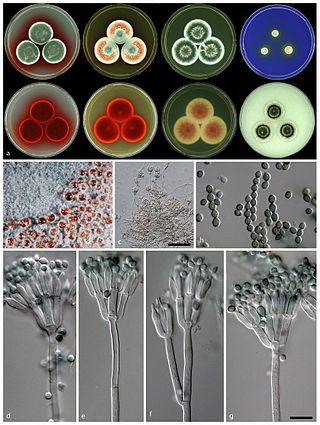
Penicillium is a genus of ascomycetous fungi that is part of the mycobiome of many species and is of major importance in the natural environment, in food spoilage, and in food and drug production.

Eurotiomycetes is a large class of ascomycetes with cleistothecial ascocarps within the subphylum Pezizomycotina, currently containing around 3810 species according to the Catalogue of Life. It is the third largest lichenized class, with more than 1200 lichen species that are mostly bitunicate in the formation of asci. It contains most of the fungi previously known morphologically as "Plectomycetes".

The Eurotiales are an order of sac fungi, also known as the green and blue molds. It was circumscribed in 1980.

The Trichocomaceae are a family of fungi in the order Eurotiales. Taxa are saprobes with aggressive colonization strategies, adaptable to extreme environmental conditions. Family members are cosmopolitan in distribution, ubiquitous in soil, and common associates of decaying plant and food material.

Aspergillus is a genus consisting of several hundred mold species found in various climates worldwide.

Penicillium chrysogenum is a species of fungus in the genus Penicillium. It is common in temperate and subtropical regions and can be found on salted food products, but it is mostly found in indoor environments, especially in damp or water-damaged buildings. It has been recognised as a species complex that includes P. notatum, P. meleagrinum, and P. cyaneofulvum. Molecular phylogeny has established that Alexander Fleming's first discovered penicillin producing strain is of a distinct species, P. rubens, and not of P. notatum. It has rarely been reported as a cause of human disease. It is the source of several β-lactam antibiotics, most significantly penicillin. Other secondary metabolites of P. chrysogenum include roquefortine C, meleagrin, chrysogine, 6-MSA YWA1/melanin, andrastatin A, fungisporin, secalonic acids, sorbicillin, and PR-toxin.

Talaromyces atroroseus is a species of fungus described as new to science in 2013. Found in soil and fruit, it was first identified from house dust collected in South Africa. The fungus produces a stable red pigment with no known toxins that, it is speculated, could be used in manufacturing, especially mass-produced foods.
Penicillium alfredii is a fungus species of the genus of Penicillium that is named after Alfred P. Sloan.
Penicillium cecidicola is a fungus species of the genus of Penicillium which produces pentacecilide A, pentacecilide B, pentacecilide C.
Penicillium ellipsoideosporum is a species of the genus of Penicillium which was isolated in China.
Penicillium flavescens is a species of the genus of Penicillium.
Penicillium osmophilum is a species of fungus in the genus Penicillium which was isolated from agricultural soil in Wageningen in the Netherlands
Penicillium roseopurpureum is an anamorph species of fungus in the genus Penicillium which produces Carviolin.
Rasamsonia is a genus of fungi in the family Trichocomaceae, circumscribed in 2011 by mycologists Jos Houbraken and Jens Frisvad. It is characterized from other genera of the Trichocomaceae by the following combination of features: species are thermotolerant or thermophilic; their conidiophores have distinctly rough-walled stipes; conidia are olive brown; and ascomata, if present, have minimal covering. Rasamsonia phenotypically resembles Paecilomyces, in that both have thermotolerant species, produce olive-brown conidia, and form ascomata with no or scarce ascomatal covering; Rasamsonia, however, differs from Paecilomyces in having more regularly branched conidiophores with distinct rough-walled structures. The type species is Rasamsonia emersonii, a fungus formerly classified in the genus Talaromyces.
Penicillium westlingii is a species of fungus in the genus Penicillium which was isolated from soil near Poznan in Poland. Penicillium westlingii produces citrinin and sterol.
Thermoascus is a genus of soil fungi in the family Trichocomaceae. Species in the genus are characterized by the production of heat-resistant ascospores. Thermoascus was circumscribed by German botanist Hugo Miehe in 1907.

Penicillium spinulosum is a non-branched, fast-growing fungus with a swelling at the terminal of the stipe (vesiculate) in the genus Penicillium. P. spinulosum is able to grow and reproduce in environment with low temperature and low water availability, and is known to be acidotolerant. P. spinulosum is ubiquitously distributed, and can often be isolated from soil. Each individual strain of P. spinulosum differs from others in their colony morphology, including colony texture, amount of sporulation and roughness of conidia and conidiophores.
Monascaceae is a former family of fungi in the subclass Eurotiomycetidae.

The Aspergillaceae are a family of fungi in the order Eurotiales which are commonly known as the blue and green molds. The family includes the commonly known and observed genera of Aspergillus and Penicillium amongst other lesser known mold genera but also includes larger ascomycete fungi such as Penicilliopsis.
Paecilomyces formosus is a species of fungus in the genus Paecilomyces in the order of Eurotiales.









